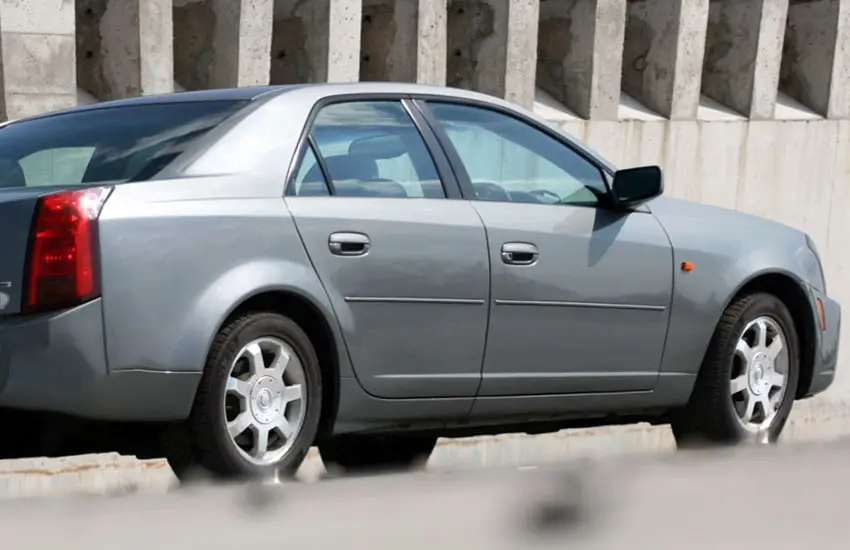As an Amazon Associate, I earn from qualifying purchases at no extra cost to you.
Car Swaying Side to Side: Expert Solutions
You might have noticed your car swaying side to side while driving. This can be a bit unsettling, especially if you’re not sure why it’s happening. In this blog post, we’ll explore the common reasons behind this annoying problem. Understanding why your car moves this way can help you stay safe on the road. Plus, we'll share some tips on how to fix it. So, let's dive in and get your ride back to feeling smooth and stable!
Car Swaying Side to Side: The Ultimate Troubleshooting Guide

1. Check Tire Pressure
The first thing you should do if your car sways side to side is check the tire pressure. Tire pressure means how much air is in your tires. It is very important to have the right amount of air in your tires because too little or too much air can cause problems when you drive. When the tires are not at the right pressure, they can be too soft or too hard. This can make your car feel wobbly or sway while you drive.
To check the tire pressure, you will need a tool called a tire pressure gauge. This is a simple device that tells you how much air is in your tires. First, make sure your car is parked on a flat surface. Then, take off the valve cap from one tire and press the gauge onto the valve stem. You will hear a hissing sound as air escapes, but this is normal. Look at the gauge to see the number. This number should match the recommended pressure for your car.
You can find this information on a sticker inside the driver’s door or in the car’s manual. If the pressure is low, you can add air using an air pump. Most gas stations have air pumps where you can fill your tires. If the tire pressure is too high, you can let some air out until it reaches the correct number. Once you finish checking all the tires, make sure they are all at the right pressure.
This small task can make a big difference in how your car handles on the road and can help reduce swaying while driving. Regularly checking your tire pressure can keep your tires healthy and make your car safer to drive.
2. Inspect Tires for Damage
The next step to fix your car swaying side to side is to inspect your tires for any damage. Tires are very important because they are the only part of your car that touches the road. If your tires are damaged, it can cause your car to feel unstable and make it sway when you drive.
To inspect your tires, start by looking at them closely. Check for any visible problems, like cuts, bulges, or cracks on the surface of the tire. A bulge is when part of the tire sticks out and looks like a bump. This can happen if the tire hits a big hole or something sharp on the road. Also, look at the tread on the tires. The tread is the part of the tire that makes contact with the road.
If the tread is worn down, it can be very dangerous, especially in rainy weather. You can use a penny to check the tread. Put a penny in the tread with Lincoln’s head facing down. If you can see all of Lincoln’s head, your tread is too worn, and you need new tires. If you find any damage, it is best to replace the tire as soon as possible.
Driving on damaged tires can lead to blowouts, which is when a tire suddenly loses air and can cause an accident. If you are not sure about the condition of your tires, it is a good idea to take your car to a mechanic. They can check your tires for you and tell you if they need to be replaced. Keeping your tires in good shape is very important for your safety and can help stop your car from swaying.
3. Examine Wheel Alignment
After checking your tire pressure and inspecting your tires, the next step is to examine your wheel alignment. Wheel alignment is about how your wheels are positioned in relation to the road and each other. When the alignment is off, it can make your car pull to one side, cause uneven tire wear, and lead to swaying.
To know if your alignment needs checking, pay attention to how your car drives. If you notice that your car pulls to one side when you are driving straight or if your steering wheel is not centered, it may be time for an alignment. You may also notice uneven wear on your tires, meaning some tires are wearing out faster than others.
Getting a wheel alignment usually requires special equipment and is best done by a professional mechanic. They will use machines to measure the angles of your wheels and adjust them to make sure they are set to the right position. This process can help improve the way your car handles and can reduce or eliminate swaying while driving.
Regularly checking your wheel alignment is a good practice, especially after hitting a big bump or pothole. Keeping your wheels aligned correctly can extend the life of your tires and make your ride smoother.
4. Check Suspension Components
Another important step to fix your car swaying side to side is to check the suspension components. The suspension system is what connects your car to the wheels and helps absorb bumps in the road. It includes parts like shocks, struts, springs, and bushings. If any of these parts are worn or damaged, it can cause your car to sway or feel unstable when driving.
To check the suspension, look for signs of wear. You can do this by pushing down on the front or back of the car. If the car bounces up and down a lot before settling, it could mean the shocks or struts are worn out. Also, inspect the rubber bushings, which are small parts that help reduce noise and vibrations. If they look cracked or damaged, they may need to be replaced.
If you are not comfortable checking these parts yourself, it is a good idea to take your car to a mechanic. They can perform a more thorough inspection of the suspension system and identify any problems. If they find worn or damaged parts, they can replace them.
Keeping the suspension in good condition is important for your safety and comfort. A well-maintained suspension system helps your car handle better on the road and can reduce swaying, especially when turning or going over bumps.
5. Look at the Steering System
Next, you should look at the steering system to help fix the swaying problem. The steering system is what allows you to control where your car goes. If there are problems with this system, it can make your car feel loose or unstable, which can cause swaying.
To check the steering system, start by inspecting the steering wheel. It should feel tight and responsive when you turn it. If you notice that the steering wheel feels loose or if it takes a lot of effort to turn, there may be a problem. Also, pay attention to any unusual noises, such as squeaking or clunking sounds, when you turn the wheel. These noises can be signs of worn components.
Look for parts like the steering rack and tie rods. The steering rack is the part that helps you turn the wheels, and the tie rods connect the steering rack to the wheels. If these parts are worn or damaged, they can affect how your car handles. You may need to take your car to a mechanic for a professional inspection if you are unsure about the condition of your steering system.
They can check for any issues and fix them if necessary. Keeping your steering system in good condition is essential for your safety and can help prevent your car from swaying while driving.
6. Check for Load Distribution
Another important step in fixing your car swaying side to side is to check the load distribution in your vehicle. Load distribution refers to how weight is balanced in your car. If the weight is uneven or if you have too much weight in one area, it can cause your car to sway or feel unstable while driving.
To check the load distribution, look at how you have packed your car. Make sure that heavy items are not all on one side. For example, if you have a lot of luggage or equipment, try to spread it out evenly in the trunk and backseat. Keeping heavy items low and toward the center of the vehicle can also help.
This will help keep your car balanced and reduce the risk of swaying. If you regularly carry heavy loads, such as tools or sports equipment, make sure you know your car’s weight limit. Exceeding this limit can make your car harder to control and can lead to swaying.
If you are not sure about the weight limit, check your car’s manual or look for a sticker inside the driver’s door. Keeping your load balanced and within the weight limit is very important for safe driving. By doing this, you can help keep your car stable on the road and reduce any swaying you may experience.
7. Test for Worn Bushings or Ball Joints
The next step is to test for worn bushings or ball joints in your car. Bushings and ball joints are important parts of the suspension system. They help keep your car stable and make sure the wheels move up and down smoothly. If these parts are worn or damaged, it can cause your car to sway or feel loose when you drive.
To check the bushings, look for rubber parts that connect different parts of the suspension. If you notice cracks, tears, or if they look very old, they may need to be replaced. For ball joints, you can check by trying to move the wheel while the car is off the ground. If you feel any play or movement that shouldn't be there, this could indicate a problem with the ball joints.
If you are not sure how to check these parts, it is best to take your car to a mechanic. They have the right tools and knowledge to inspect your suspension system thoroughly. If they find that the bushings or ball joints are worn, they can replace them for you.
Replacing worn bushings or ball joints can improve your car’s handling and help reduce swaying while driving. Regularly checking these parts can also help you catch problems early before they become bigger issues.
8. Professional Inspection
If your car still sways side to side after checking all the previous steps, it may be time for a professional inspection. Sometimes, the problems causing your car to sway can be more complicated and not easy to see. A professional mechanic has the experience and tools to diagnose issues that you may not notice.
I hope this guide helps you fix your car swaying side to side. By checking your tires, alignment, suspension, steering, and load distribution, you can make your car safer and easier to drive. If problems continue, don't hesitate to ask a mechanic for help. Keeping your car in good shape will give you a smoother, safer ride.
Are These Questions in Your Mind?
Is it normal for my car to sway a little while driving?
Yes, a small amount of sway can be normal, especially when driving on uneven roads. However, if the swaying is noticeable or feels dangerous, you should check your car for issues.
Can I fix car swaying myself, or should I go to a mechanic?
You can check simple things like tire pressure and load distribution yourself. However, for more complex issues, like alignment or suspension problems, it’s best to go to a mechanic.
Do I need special tools to check my car for swaying issues?
While you may only need a tire pressure gauge for basic checks, some tasks, like alignment and suspension inspection, often require special tools that mechanics use.
Is it safe to drive my car if it is swaying?
If your car is swaying significantly, it may not be safe to drive. It is best to address the issue before driving long distances or at high speeds.
Can bad weather make my car sway more?
Yes, bad weather, like strong winds or wet roads, can make your car sway more. It’s important to drive carefully and adjust your speed in these conditions.
Do I have to check my tires regularly?
Yes, checking your tires regularly for pressure and wear can help prevent swaying and other driving issues. It's a good habit to check them every month.
Is it possible for a heavy load to cause swaying?
Yes, carrying a heavy or uneven load can cause your car to sway. Make sure to distribute weight evenly and stay within the recommended weight limits.
Can worn-out tires cause my car to sway?
Yes, worn-out or damaged tires can lead to swaying and instability. It’s important to replace tires when they show signs of wear.
Do I need to get my car aligned regularly?
Yes, getting your car aligned regularly is important, especially if you hit bumps or potholes. Regular alignments can help prevent swaying and improve handling.
Is it common for older cars to sway more than newer ones?
Older cars may sway more if their parts are worn out or not maintained properly. Newer cars usually have better suspension systems, which can help reduce swaying.











